Palo Alto Networks Bundle
How Did Palo Alto Networks Conquer the Cybersecurity World?
Founded in 2005, Palo Alto Networks disrupted the network security landscape with a groundbreaking platform designed to secure networks and applications. From its Santa Clara beginnings, the company recognized the limitations of traditional firewalls, setting the stage for a new era of cybersecurity. This Palo Alto Networks SWOT Analysis will delve into the company's journey.
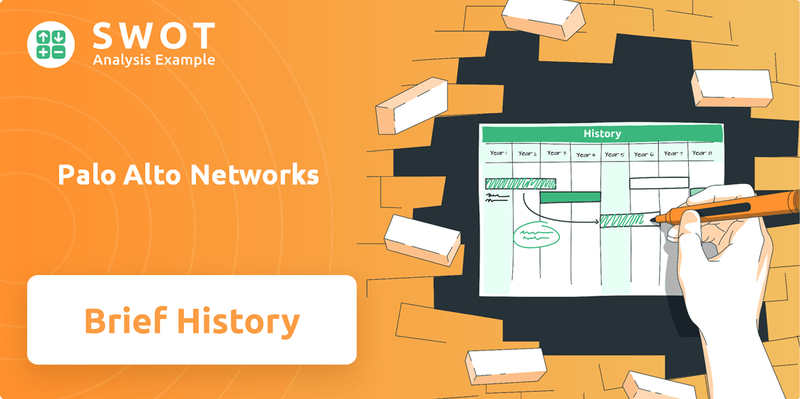
This brief history of Palo Alto Networks explores the evolution of a cybersecurity company that has become a global leader. Examining the company timeline reveals key milestones, from its early years to its current market dominance. Understanding Palo Alto Networks' financial performance and strategic decisions provides valuable insights into the company's success in the network security sector.
What is the Palo Alto Networks Founding Story?
The story of Palo Alto Networks, a leading cybersecurity company, began in 2005. Founded by Nir Zuk, the company emerged with a vision to redefine network security. This marked the start of a journey that would transform the industry.
Nir Zuk, the Palo Alto Networks founder, brought extensive experience from Check Point and NetScreen Technologies. His deep understanding of firewall technology and network security was crucial. This expertise laid the foundation for the company's innovative approach to cybersecurity. The company's early years were marked by a focus on addressing the evolving needs of network security in a changing technological landscape.
The initial concept for Palo Alto Networks was built on three main ideas. First, the increasing demand for network security due to growing application complexity. Second, the effect of virtualization on application communication, which called for new firewall approaches. Finally, the expectation of a shift away from the traditional 'box' business model, which was dominated by companies like Juniper and Cisco, towards software-defined networking.
Palo Alto Networks launched its first product in 2007, introducing a 'Next-Generation Firewall' platform. This platform offered enhanced visibility and control over users and content within the firewall, enabling applications safely. This innovative approach quickly positioned the company as a leader in the market.
- The company's initial funding came from various venture capital firms.
- The focus was on creating a new generation of network security solutions.
- Nir Zuk's expertise was key in identifying and addressing market gaps.
- The company's early success was driven by its innovative Next-Generation Firewall.
The company's early success was driven by its innovative Next-Generation Firewall. This platform provided enhanced visibility and control over users and content within the firewall, enabling applications safely. The company's ability to innovate and adapt has been a key factor in its growth and market leadership. For a deeper understanding of the competitive environment, consider exploring the Competitors Landscape of Palo Alto Networks.
Throughout its history, Palo Alto Networks has consistently adapted to the changing cybersecurity landscape. The company's evolution reflects its commitment to innovation and its ability to meet the evolving needs of its customers. This adaptability has been crucial in maintaining its position as a leader in the cybersecurity industry.
Palo Alto Networks SWOT Analysis
- Complete SWOT Breakdown
- Fully Customizable
- Editable in Excel & Word
- Professional Formatting
- Investor-Ready Format
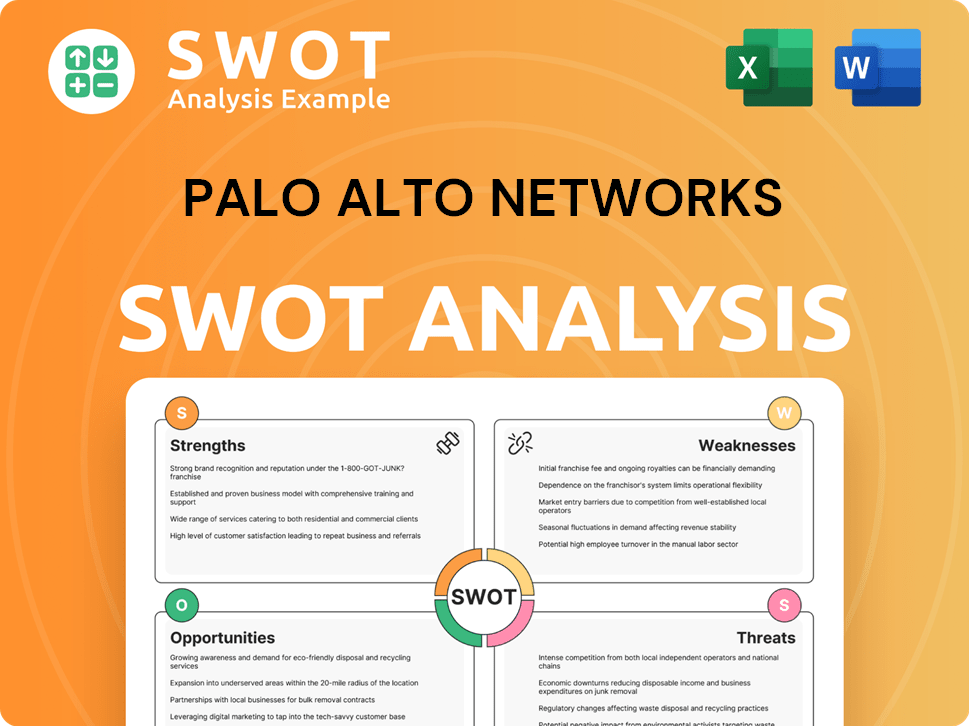
What Drove the Early Growth of Palo Alto Networks?
The early years of Palo Alto Networks were marked by rapid growth and significant market impact. Following the introduction of its first product in 2007, the cybersecurity company quickly established itself as a leader in the network security sector. This swift ascent showcased strong market acceptance, challenging established players in the industry. This period laid the foundation for the company's future expansion and its evolution into a major player in the network security landscape.
Palo Alto Networks disrupted the market with its innovative Next-Generation Firewall, earning a top position in Gartner's Magic Quadrant by 2011. The company's initial public offering (IPO) on July 20, 2012, raised $260 million, making it the fourth-largest tech IPO of that year. This financial infusion provided the resources needed for further expansion and strategic initiatives.
Beyond its core firewall business, Palo Alto Networks broadened its product offerings. By March 2023, the firewall business still represented over 60% of revenue, demonstrating its continued importance. The company strategically entered new categories, such as Cortex and Prisma Cloud, which by March 2023, had a $2 billion run rate and were growing at 60% year-over-year.
Key leadership changes, such as Nikesh Arora becoming Chairman and CEO in June 2018, influenced the company's strategic direction. Acquisitions were a crucial part of Palo Alto Networks' growth strategy, with 21 acquisitions completed by April 2025. Notable acquisitions included Talon Cyber Security in November 2023 for $600 million and Dig Security in September 2023.
In August 2024, Palo Alto Networks acquired IBM's QRadar SaaS business for $1.14 billion, aiming to transition customers to its XSIAM platform. This strategic move enhanced its security offerings. By 2024, the company had a growing customer base of over 70,000 organizations in more than 150 countries, including 85 of the Fortune 100, underscoring its global reach and impact. To learn more about the company's values, check out Mission, Vision & Core Values of Palo Alto Networks.
Palo Alto Networks PESTLE Analysis
- Covers All 6 PESTLE Categories
- No Research Needed – Save Hours of Work
- Built by Experts, Trusted by Consultants
- Instant Download, Ready to Use
- 100% Editable, Fully Customizable
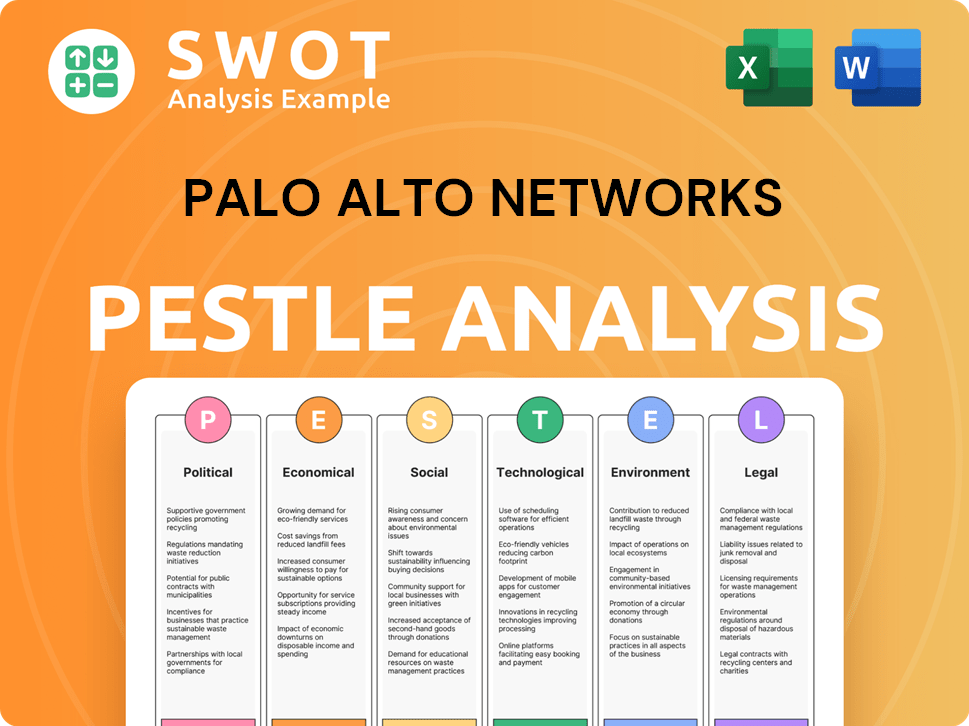
What are the key Milestones in Palo Alto Networks history?
The journey of Palo Alto Networks has been marked by significant milestones, from its inception to its current status as a leading cybersecurity company. The company's evolution reflects its commitment to innovation and adaptation in the face of evolving cyber threats. Understanding the Palo Alto Networks history provides valuable insights into its strategic moves and market positioning.
| Year | Milestone |
|---|---|
| 2005 | Palo Alto Networks was founded, marking the beginning of its journey in the cybersecurity sector. |
| 2011 | The company's Next-Generation Firewall positioned it as a leader in Gartner's Magic Quadrant for Enterprise Network Firewalls. |
| 2012 | Palo Alto Networks went public with its IPO, a significant step in its growth. |
| 2014 | The company expanded its focus to include cloud security solutions. |
| 2024 | Palo Alto Networks initiated a 'platformization' strategy to consolidate its security offerings. |
| 2025 | Planned acquisition of Protect AI to enhance AI security capabilities. |
Palo Alto Networks has consistently demonstrated innovation in the cybersecurity field. The introduction of its Next-Generation Firewall was a groundbreaking move, setting a new standard for network security. The company has expanded its portfolio to include cloud security, security operations, and AI-powered solutions, reflecting its commitment to addressing the evolving needs of its clients. Its platformization strategy aims to unify security functions, enhancing threat detection and response capabilities.
This innovation disrupted the market, establishing Palo Alto Networks as a leader in network security. It provided advanced threat prevention capabilities beyond traditional firewalls.
A comprehensive SASE (Secure Access Service Edge) solution that integrates network and security functions. It enables secure access to applications and data from anywhere.
A cloud-native application protection platform (CNAPP) designed to secure cloud environments. It provides visibility, compliance, and threat protection across multi-cloud deployments.
An extended detection and response (XDR) platform that integrates data from multiple security tools. It provides comprehensive threat detection, investigation, and response capabilities.
A security orchestration, automation, and response (SOAR) platform that automates security workflows. It streamlines incident response and improves operational efficiency.
Integration of AI into platforms to analyze vulnerabilities, improve threat detection, and enhance operational efficiencies. This includes the planned acquisition of Protect AI in April 2025.
Despite its successes, Palo Alto Networks has faced several challenges. The cybersecurity market is highly competitive, requiring continuous innovation to stay ahead. The company's 'platformization' strategy, while strategically sound, initially impacted billings and revenue growth. The evolving threat landscape, including the rise of AI-driven cyberattacks, presents ongoing challenges that require constant adaptation and investment. For more information, you can read about the Owners & Shareholders of Palo Alto Networks.
Palo Alto Networks faces competition from other major cybersecurity vendors. The company must continually innovate to maintain its market position and address evolving threats.
Adapting to changing market demands and customer needs is crucial. The company's platformization strategy is a response to customer 'spending fatigue' from disparate point solutions.
The cybersecurity landscape is constantly evolving, with new threats emerging regularly. The rise of AI in both attack and defense strategies presents ongoing challenges.
Balancing investments in innovation with financial goals is essential. The company must manage its expenses and ensure sustainable growth.
Successfully integrating acquired companies and technologies is crucial for expanding capabilities. The planned acquisition of Protect AI is an example of this.
Navigating and complying with evolving cybersecurity regulations is essential. This includes data privacy laws and industry-specific standards.
Palo Alto Networks Business Model Canvas
- Complete 9-Block Business Model Canvas
- Effortlessly Communicate Your Business Strategy
- Investor-Ready BMC Format
- 100% Editable and Customizable
- Clear and Structured Layout
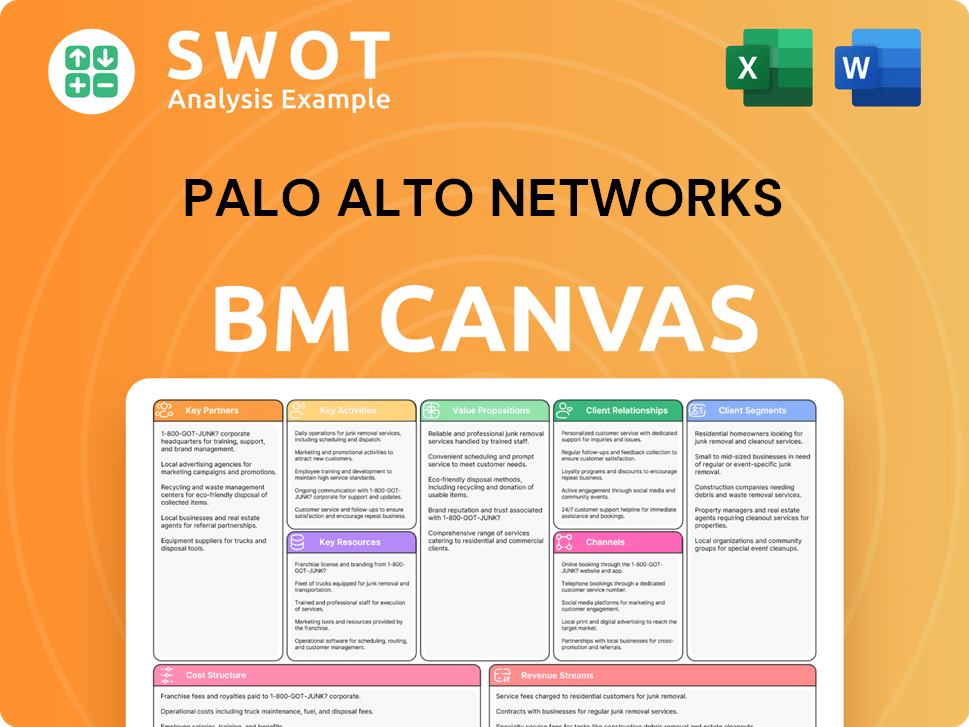
What is the Timeline of Key Events for Palo Alto Networks?
The journey of Palo Alto Networks, a leading cybersecurity company, is marked by significant milestones, from its inception to its current market position. The company's evolution reflects its commitment to innovation and strategic growth in the ever-changing cybersecurity landscape. Understanding the Marketing Strategy of Palo Alto Networks provides further insights into its success.
| Year | Key Event |
|---|---|
| 2005 | Palo Alto Networks was founded by Nir Zuk in Santa Clara, California. |
| 2007 | The company launched its first product, a Next-Generation Firewall, marking its entry into the network security market. |
| 2011 | Palo Alto Networks was recognized as a leader in Gartner's Magic Quadrant for Enterprise Network Firewalls. |
| July 20, 2012 | Palo Alto Networks went public on the NYSE, raising $260 million and expanding its financial resources. |
| 2014 | Palo Alto Networks surpassed Check Point to become the world's largest security company. |
| June 2018 | Nikesh Arora was appointed as Chairman and CEO. |
| 2019 | The company began focusing on its 'platformization' strategy to integrate various security functions. |
| October 2021 | Palo Alto Networks moved its listing to Nasdaq. |
| August 2024 | Palo Alto Networks acquired IBM's QRadar SaaS business for $1.14 billion. |
| Fiscal Year 2024 | The company reported total revenue of $8.03 billion, reflecting a 16.46% year-over-year increase. |
| Q4 2024 | Palo Alto Networks led the network security market with a 28.4% market share. |
| November 2024 | Reported Q1 FY2025 revenue of $2.14 billion, a 14% year-over-year increase, with Next-Generation Security (NGS) ARR growing 40% to $4.52 billion. |
| April 2025 | Announced plans to acquire Protect AI to enhance its AI security capabilities. |
| May 20, 2025 | Reported fiscal Q3 2025 revenue of $2.3 billion, a 15% year-over-year increase, and NGS ARR of $5.1 billion, a 34% year-over-year increase. |
Palo Alto Networks is focused on its 'platformization' strategy, aiming to create a unified, AI-powered security platform. This approach simplifies security management and enhances threat detection and response. The company plans to expand its platformization customer base, targeting 2,500 to 3,500 customers by fiscal year 2030.
AI is a crucial focus for Palo Alto Networks, anticipating an 'AI versus AI cyber arms race' in 2025. They are investing heavily in AI capabilities, including AI model scanning and runtime security. This includes initiatives like the new Prisma AIRS platform to enhance their AI security offerings.
For fiscal year 2025, Palo Alto Networks projects total revenue between $9.17 billion and $9.19 billion. They anticipate diluted non-GAAP net income per share of $3.26 to $3.28. Analysts forecast approximately 22% earnings growth, driven by expected operating margin improvements.
Palo Alto Networks aims to achieve real-time security across a company's entire security estate. The company is positioning itself to potentially become the first $100 billion cybersecurity company. This vision aligns with its founding goal of providing comprehensive network security solutions.
Palo Alto Networks Porter's Five Forces Analysis
- Covers All 5 Competitive Forces in Detail
- Structured for Consultants, Students, and Founders
- 100% Editable in Microsoft Word & Excel
- Instant Digital Download – Use Immediately
- Compatible with Mac & PC – Fully Unlocked
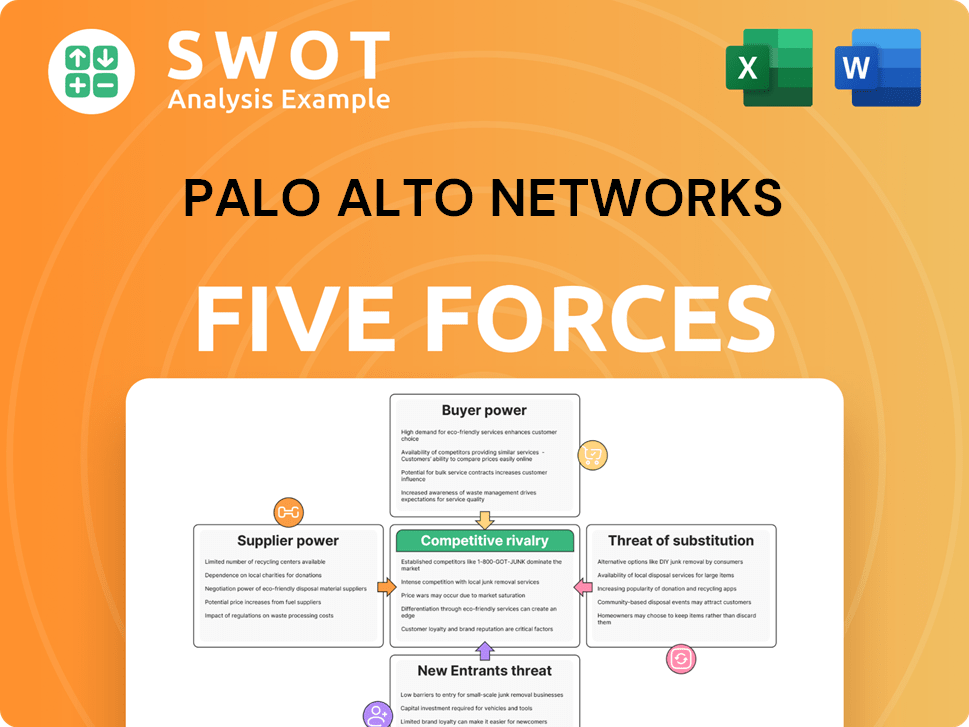
Related Blogs
- What is Competitive Landscape of Palo Alto Networks Company?
- What is Growth Strategy and Future Prospects of Palo Alto Networks Company?
- How Does Palo Alto Networks Company Work?
- What is Sales and Marketing Strategy of Palo Alto Networks Company?
- What is Brief History of Palo Alto Networks Company?
- Who Owns Palo Alto Networks Company?
- What is Customer Demographics and Target Market of Palo Alto Networks Company?
Disclaimer
All information, articles, and product details provided on this website are for general informational and educational purposes only. We do not claim any ownership over, nor do we intend to infringe upon, any trademarks, copyrights, logos, brand names, or other intellectual property mentioned or depicted on this site. Such intellectual property remains the property of its respective owners, and any references here are made solely for identification or informational purposes, without implying any affiliation, endorsement, or partnership.
We make no representations or warranties, express or implied, regarding the accuracy, completeness, or suitability of any content or products presented. Nothing on this website should be construed as legal, tax, investment, financial, medical, or other professional advice. In addition, no part of this site—including articles or product references—constitutes a solicitation, recommendation, endorsement, advertisement, or offer to buy or sell any securities, franchises, or other financial instruments, particularly in jurisdictions where such activity would be unlawful.
All content is of a general nature and may not address the specific circumstances of any individual or entity. It is not a substitute for professional advice or services. Any actions you take based on the information provided here are strictly at your own risk. You accept full responsibility for any decisions or outcomes arising from your use of this website and agree to release us from any liability in connection with your use of, or reliance upon, the content or products found herein.